How great Thou art, How great Thou art!
New Haven (Google Maps Location)
November 26, 2008
The Yale Art Gallery is a Connecticut Art Trail site
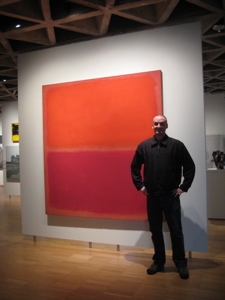 The Yale Art Gallery is huge. Too huge for me to even pretend to do it justice here. Put it this way: If you are at least a little bit interested in art – good, real, famous art mind you – get yourself to Yale and spend a couple hours at this free, yes FREE museum. Perhaps Hoang and I were caught off guard because this place refers to itself as a mere “gallery.” Perhaps because it’s free… I don’t know, but I can tell you we were happily shocked by how cool the collection here is.
The Yale Art Gallery is huge. Too huge for me to even pretend to do it justice here. Put it this way: If you are at least a little bit interested in art – good, real, famous art mind you – get yourself to Yale and spend a couple hours at this free, yes FREE museum. Perhaps Hoang and I were caught off guard because this place refers to itself as a mere “gallery.” Perhaps because it’s free… I don’t know, but I can tell you we were happily shocked by how cool the collection here is.
And get this: It was only now, after writing this post and reading the gallery’s website, that I learned three whole exhibits were closed during our visit! Oh well.
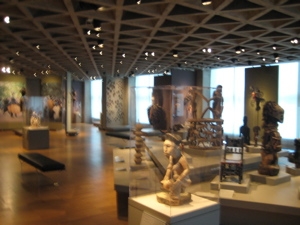 I’m almost embarrassed to write this post. I’ve mentioned before how I avoided art museums for a while, because I knew writing about them would be difficult. I’ve managed… But not very well. I’m sitting here staring at 10 different wordy brochures I gathered at the gallery wondering how to capture the whole place without boring everyone, including me, to tears.
I’m almost embarrassed to write this post. I’ve mentioned before how I avoided art museums for a while, because I knew writing about them would be difficult. I’ve managed… But not very well. I’m sitting here staring at 10 different wordy brochures I gathered at the gallery wondering how to capture the whole place without boring everyone, including me, to tears.
I guess the first step would be to stop lamenting my inner turmoil and just get going with it already. The second would be to mention that I utilized the gallery’s excellent website to help me out here. Note – the site allows you to click on a piece of artwork to not only view it, but to learn about it as well… Definitely cool.
With a day off from work and Damian at daycare, Hoang and I hit New Haven for some shopping, lunch, and sightseeing. Having already been to the excellent Art and Architecture Galleries a few blocks away, we were excited for some more smart people culture.
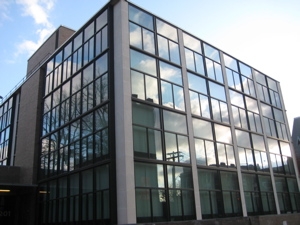 And since we’d just learned all about Yale’s famous architecture school and learned about a bunch of the famous on campus buildings, I’d be a fool to not mention the Art Gallery building, designed by none other than Louis I. Kahn. The Yale University Art Gallery was Kahn’s first significant commission and is widely considered his first masterpiece.
And since we’d just learned all about Yale’s famous architecture school and learned about a bunch of the famous on campus buildings, I’d be a fool to not mention the Art Gallery building, designed by none other than Louis I. Kahn. The Yale University Art Gallery was Kahn’s first significant commission and is widely considered his first masterpiece.
Designed while Kahn was a visiting critic at the Yale School of Architecture, the building -the first of three art museums that he would design – represented a dramatic point of departure for American museum architecture as a whole. Constructed of brick, concrete, glass, and steel, and presenting a windowless wall along its most public facade, the building was a radical break from the neo-Gothic buildings that characterize much of the campus, including the adjacent Swartwout building.
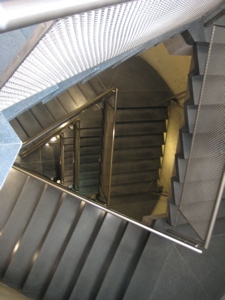
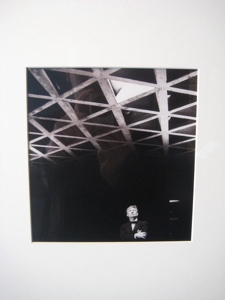
Kahn’s design has been celebrated not only for its beauty, geometry, and light, but also for its structural and engineering innovations. Among these is the housing of electrical and ventilating systems in hollow concrete tetrahedrons that make up the ceiling, appearing to float overhead. When it opened in November 1953, the “Yale University Art Gallery and Design Center” included expansive, open spaces for the exhibition of art, as well as studio space for use by art and architecture students.
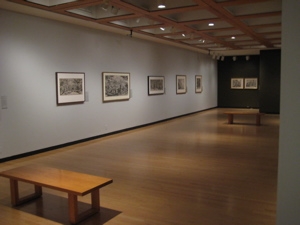 Kahn was yet another fascinating artistic genius with a troubled life. What is it with these mid-century architects? Philip Johnson, Frank Lloyd Wright, Corbusier, Van der Rohe, Paul Rudolph, Kahn… Jerks, misanthropes, adulterers, racists. Kahn’s life and work has been wonderfully chronicled in “My Architect,” a documentary by his illegitimate son. Check out this 10 minute clip containing a few other CTMQ sites, including the Yale Museum of British Art across the street.
Kahn was yet another fascinating artistic genius with a troubled life. What is it with these mid-century architects? Philip Johnson, Frank Lloyd Wright, Corbusier, Van der Rohe, Paul Rudolph, Kahn… Jerks, misanthropes, adulterers, racists. Kahn’s life and work has been wonderfully chronicled in “My Architect,” a documentary by his illegitimate son. Check out this 10 minute clip containing a few other CTMQ sites, including the Yale Museum of British Art across the street.
Let’s go inside. Note my cool picture of the stairs above.
The first floor contains the gift shop, a sculpture garden, the Ancient Art, and Art of the Ancient Americas exhibits. It also houses one of the “Special Exhibition” areas which during our visit was “Grand Scale: Monumental Prints in the age of Durer and Titian.” Yeah, I know… Not too exciting.
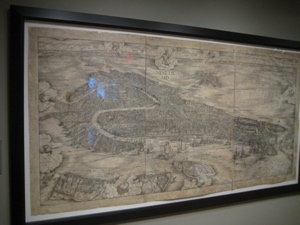
Venice
But it is somewhat interesting and this stuff is definitely old: “This exhibition showcases mural-size prints from the late fifteenth century to 1630, when ambitions to rival painted images, to assert and justify political rule, or simply to adorn wall surfaces—prompted printed imagery to expand. Surviving in far fewer numbers than smaller prints, mural-size print ensembles sometimes reached over ten feet in height and stretched to sixteen feet in length. Grand Scale displays approximately fifty oversize prints from the German, Italian, and Netherlandish schools, including compositions by Sandro Botticelli, Albrecht Dürer, Titian, Jacopo Tintoretto, Bartholomaeus Spranger, and Peter Paul Rubens.”
 Enough of that. Over at the Ancient Art area… Wait, I didn’t see any Ancient art. Oh, it says here on my brochure that it was closed for restoration at the time of my visit. So I’ve borrowed a couple images from the gallery website to give more oomph to my story. At least I’d been to The Slater Memorial Art Museum to see a bunch of fake versions of this stuff a couple weeks prior. From the Gallery’s website:
Enough of that. Over at the Ancient Art area… Wait, I didn’t see any Ancient art. Oh, it says here on my brochure that it was closed for restoration at the time of my visit. So I’ve borrowed a couple images from the gallery website to give more oomph to my story. At least I’d been to The Slater Memorial Art Museum to see a bunch of fake versions of this stuff a couple weeks prior. From the Gallery’s website:
“Yale’s art from the ancient Mediterranean world comprises over 13,000 objects from the Near East, Egypt, Greece, Etruria, and Rome that range in date from the Neolithic through the early Byzantine periods. The collection is perhaps best known for its important finds from the Yale University excavations in the 1930s at Dura-Europos in Syria, and Gerasa in Jordan. Paintings and sculpture from Dura’s Jewish, Christian, and pagan houses of worship and the more than 7,500 artifacts of daily life found by the archaeologists present a vivid picture of life in an ancient Roman city, while the mosaics from Gerasa represent the best of early Byzantine church mosaic production in Jordan.”
 It goes on from there. Also unfortunately closed was the Art of the Ancient Americas exhibit. The art of this collection is shared with Yale’s Peabody Museum of Natural History, known for its excavations at Machu Picchu; the two museums lend works back and forth for exhibition and study.
It goes on from there. Also unfortunately closed was the Art of the Ancient Americas exhibit. The art of this collection is shared with Yale’s Peabody Museum of Natural History, known for its excavations at Machu Picchu; the two museums lend works back and forth for exhibition and study.
This relatively recent collection was founded on the gifts of Mr. and Mrs. Fred Olsen in the 1950s, which provided a representative base of Mesoamerican art. Further acquisitions from the Olsen collection in the 1970s added several exceptional highlights. Among these are outstanding Jaina terra-cotta figurines from the Maya period and striking figures and house models from western Mexico. Particularly important and rare is the clay model of a ball game, which is complemented by a yoke, hachas, and additional items related to this ancient sporting activity.
Up one flight of stairs we entered the African Art gallery. The parallels between this art and the Ancient Americas art is rather interesting. Two highly distinct cultures that may well have been on different planets back then with so much overlapping style.
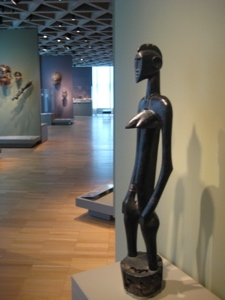
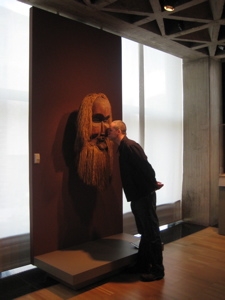
The collection is strongest in ritual figures and masks from West and Central Africa. There are also several specialized collections, such as Christian crosses from Ethiopia and miniature masks from Liberia. Several ancient African civilizations are represented, including the Djenne, Nok, Koma, Sapi, and Benin. Some of the outstanding objects: from the Sahel area, a Bamana wooden equestrian figure; from the Upper Guinea Coast, a Senufo figurative rhythm pounder and a Temne bush cow mask; from the Lower Guinea Coast, an elaborate Ejagham skin-covered headdress and a Fante appliquéd banner; from Central Africa, a Luba female figure with bowl and a Fang female reliquary figure; and from southern Africa, an elegant Zulu stool, below
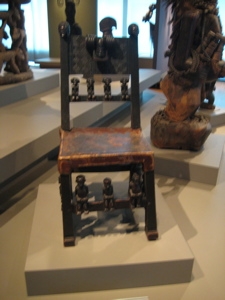
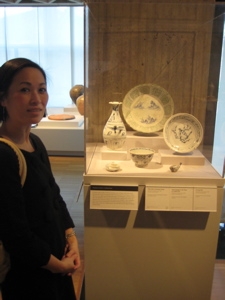
.
We crossed over to the Asian Art area which has many stunning pieces to show. With approximately 6,000 objects, the Asian art collection encompasses the regions of East Asia (China, Korea, and Japan), Southeast Asia, South Asia, and the Near East from the Islamic era.
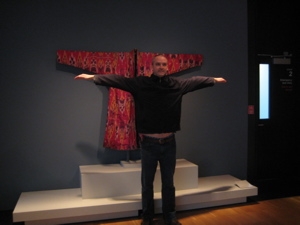 The greatest strengths of the Chinese collections lie in ceramics and painting. These include a special group of vessels from the Changsha region of Hunan Province, spanning ca. 500 B.C.E. to C.E. 1000. Chinese paintings range from the Tang dynasty (618–907) through the twentieth century.
The greatest strengths of the Chinese collections lie in ceramics and painting. These include a special group of vessels from the Changsha region of Hunan Province, spanning ca. 500 B.C.E. to C.E. 1000. Chinese paintings range from the Tang dynasty (618–907) through the twentieth century.
The Japanese collection has important concentrations in the arts of the Edo period (1615–1868). Approximately 1,000 prints, the majority of which are ukiyo-e prints from the eighteenth and nineteenth centuries, demonstrate the breadth of this medium and recent acquisitions have included a group of twentieth-century prints. Several important seventeenth-century screens highlight the department’s holdings in Japanese painting. Japanese textiles are represented by fragments from the ShÅsÅin repository in Nara, Noh robes, kimonos, and a collection of Buddhist priests’ robes, and modern ceramic work by a significant number of objects from the twentieth century.
The South Asian and Islamic collections feature an excellent group of textiles, ceramics, miniature paintings, and manuscript pages.
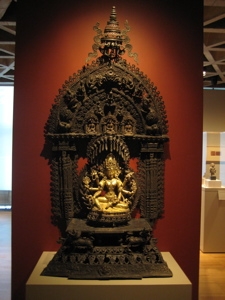
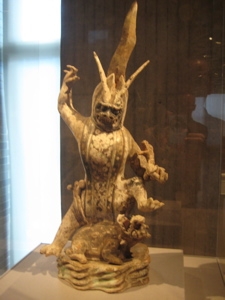
Hoang and I spent a fair amount of time here, as we both find a lot of this stuff really cool. But we had to move on, up to another level to check out some Early European Art!
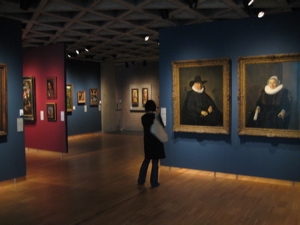 Here’s where we were really blown away. The collection is huge and beautiful. The gallery space is transporting. As CTMQ readers well know, I’m not exactly an art critic or historian or even much of a buff. But sometimes I think to myself, “Man, I really should learn more about this stuff.”
Here’s where we were really blown away. The collection is huge and beautiful. The gallery space is transporting. As CTMQ readers well know, I’m not exactly an art critic or historian or even much of a buff. But sometimes I think to myself, “Man, I really should learn more about this stuff.”
The collection of early European art at Yale comprises paintings, textiles, and a small group of sculpture and decorative arts, spanning the ninth to the mid-nineteenth centuries, with a base of over 1,000 objects. The painting collection is panoramic in range, with particular strength in Italian art of the Renaissance. Featuring one of the largest and finest groups of thirteenth- and fourteenth-century Tuscan paintings in the world, it also contains a significant number of Sienese fifteenth-century paintings and such acknowledged masterworks as Gentile da Fabriano’s Virgin and Child (ca. 1424-25), Antonio Pollaiuolo’s Hercules and Deianira (ca. 1470), and Pontormo’s Madonna del Libro (ca. 1545-46).
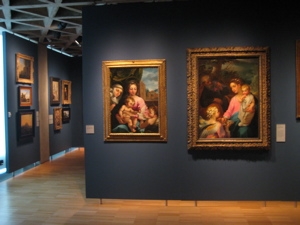 The early Italian holdings are complemented by Northern Renaissance art, including Hieronymus Bosch’s Allegory of Intemperance (ca. 1495-1500) and Hans Holbein’s Hanseatic Merchant (1538), along with Dutch seventeenth-century landscape and portraiture, highlighted by Frans Hals’s De Heer Bodolphe and Mevrouw Bodolphe, and a select group of paintings and oil sketches by Peter Paul Rubens and Anthony van Dyck. Seventeenth- and eighteenth-century French and eighteenth-century Italian art are also well represented. The nineteenth-century French collections include important paintings by Eugene Delacroix, Jean-Baptiste-Camille Corot, Jean-Francois Millet, and Jean-Leon Goerme.
The early Italian holdings are complemented by Northern Renaissance art, including Hieronymus Bosch’s Allegory of Intemperance (ca. 1495-1500) and Hans Holbein’s Hanseatic Merchant (1538), along with Dutch seventeenth-century landscape and portraiture, highlighted by Frans Hals’s De Heer Bodolphe and Mevrouw Bodolphe, and a select group of paintings and oil sketches by Peter Paul Rubens and Anthony van Dyck. Seventeenth- and eighteenth-century French and eighteenth-century Italian art are also well represented. The nineteenth-century French collections include important paintings by Eugene Delacroix, Jean-Baptiste-Camille Corot, Jean-Francois Millet, and Jean-Leon Goerme.
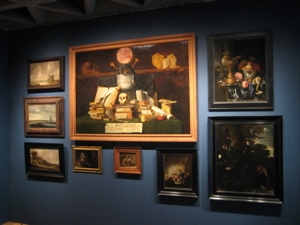
Bosch (I think)
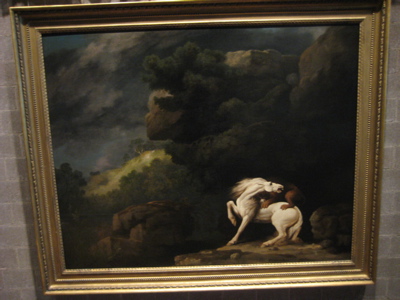
I love this painting, but have no idea who painted it.
Yeah. What they said. Many of the paintings were the type that draw you in and make you stare for a good long minute, wondering how some people have such talent and others, like me, can’t draw a circle without messing up. We both really enjoyed this particular exhibit, but it was time to check out something more contemporary.
The juxtaposition between the classical art exhibit and the modern art exhibit is a bit startling. I say that as more of a fan of modern art than the old stuff… but at the same time, some modern art deserves the armchair criticism is receives. For example, more or less next to each other are:
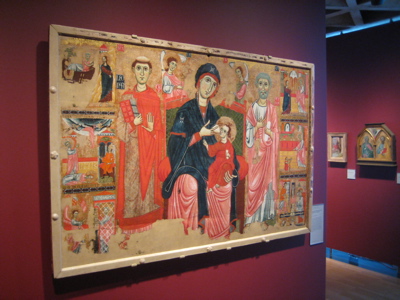
Master of the Magdalen’s “Virgin and Child Enthroned with Saints Leonard and Peter” and…
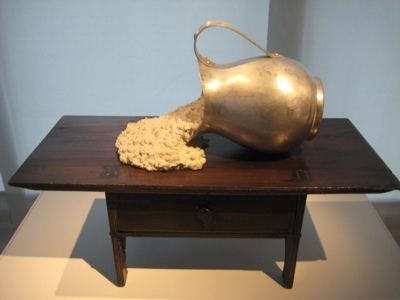
pitcher spilling old oatmeal on an old credenza
That’s what kills me about contemporary art. I absolutely love much of it and our home is adorned with various Rothko and Sam Francis prints. I enjoyed the Rothko, Pollock, and Mondrian works here. They have Picassos, and Sol Lewitt and Chuck Close paintings. Here, I’ll let them brag…
Modern and contemporary art at the Gallery includes painting and sculpture from the mid-nineteenth century to the present. The modern collection features masterworks by artists such as Constantin Brancusi, Paul Cezanne, and Pablo Picasso, and includes Vincent van Gogh’s famous painting The Night Cafe (1888)… The collection comprises a rich array of paintings, drawings, prints, and sculptures by major twentieth-century artists, including Duchamp, Max Ernst, Wassily Kandinsky, Fernand Léger, El Lissitzky, Piet Mondrian, and Kurt Schwitters.
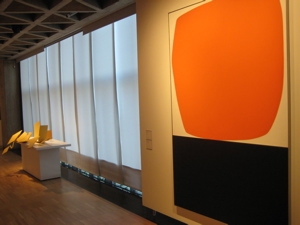
Art! (Ellsworth Kelly’s Charter)
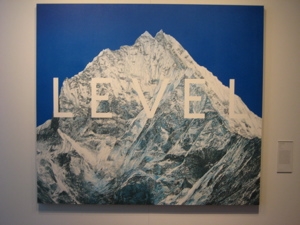
Not
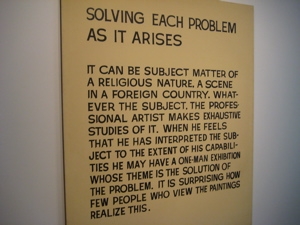
Not
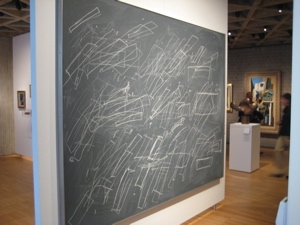
Not
I’m not sure which is the lamest one… I’ll go with the chalk scribbles… Art World, please explain that to us. “The dry, chalkboard-gray field of this untitled painting affirms a reading of the vigorous, multidirectional lines across its surface as an abstract visual language. Twombly is known for his consistent interrogation of the practice of painting as a vehicle for expression and articulation. Playing the tools of abstraction (line and form) against words and more figurative elements, the artist has developed an abstract vocabulary that is emotionally and visually dynamic.”
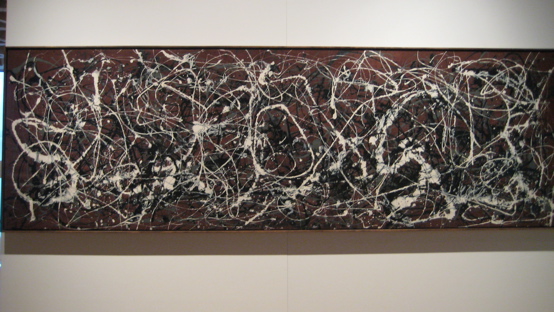
Great art (Pollock)
The modern and contemporary art collection culminates in the dynamism of American art after the war. Highlights include Jackson Pollock’s Number 13A: Arabesque (1948, above) and Roy Lichtenstein’s Blam (1962), given with other important postwar works to the Gallery by Richard Brown Baker. Significant works by artists such as Claes Oldenburg, Mark Rothko, Robert Rauschenberg, Jasper Johns, Frank Stella, and Andy Warhol are also featured. The Gallery’s collection of art from the 1970s to the present includes works by John Baldessari, Matthew Barney, Chuck Close, Eva Hesse, Roni Horn, Donald Judd, Sol Lewitt, Robert Morris, Martin Puryear, Gerhard Richter, Dieter Roth, and Do-Ho Suh.
I happen to think Marcel Duchamp is lame and Andy Warhol is grossly overrated. But what do I know? Well, I know a pile of carpet pieces or a picture of a mountain are tenuously art by any measure.
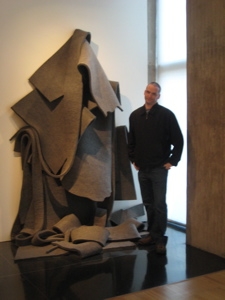
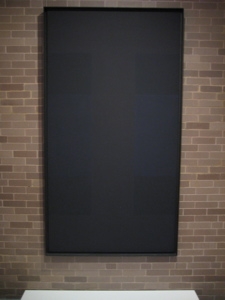
Awesome. Re: Robert Morris’s pile of carpet (Untitled): “Random piling, loose stacking, hanging, give passing form to the material. Chance is accepted and indeterminacy is implied since replacing will result in another configuration. Disengagement with preconceived enduring forms and orders for things is a positive assertion. It is part of the work’s refusal to continue estheticizing form by dealing with it as a prescribed end.”
Amazingly, there was another whole wing that was closed for restoration – the American Art exhibit. I’m a bit bummed out by that because they house some of my favorite straightforward American painters (Hopper, Eakins, Homer…)
 Yale’s rich collection of American paintings and sculpture offers a teaching resource unparalleled in any university museum; as a public museum collection it ranks among the nation’s top collections of American art. The collection has a long history, beginning in 1750, when Yale acquired its first American painting, a 1670 portrait of the Reverend John Davenport. In 1831, the patriot-artist John Trumbull gave more than one hundred of his portraits and historical paintings to Yale and designed a building to house them. Today, the Art Gallery’s American collection includes more than 2,500 paintings, 500 sculptures, and 300 miniatures, all created before the mid-twentieth century. Virtually every period in American history is represented through paintings by Benjamin West, John Singleton Copley, Albert Bierstadt, Frederic Church, Frederick Remington, Thomas Eakins, Winslow Homer, George Bellows, John Singer Sargent, Arthur Dove, and Edward Hopper, and sculptures by Hezekiah Augur, Hiram Powers, Horatio Greenough, William Henry Rinehart, Chauncey B. Ives, Alexander Archipenko, and Alexander Calder.
Yale’s rich collection of American paintings and sculpture offers a teaching resource unparalleled in any university museum; as a public museum collection it ranks among the nation’s top collections of American art. The collection has a long history, beginning in 1750, when Yale acquired its first American painting, a 1670 portrait of the Reverend John Davenport. In 1831, the patriot-artist John Trumbull gave more than one hundred of his portraits and historical paintings to Yale and designed a building to house them. Today, the Art Gallery’s American collection includes more than 2,500 paintings, 500 sculptures, and 300 miniatures, all created before the mid-twentieth century. Virtually every period in American history is represented through paintings by Benjamin West, John Singleton Copley, Albert Bierstadt, Frederic Church, Frederick Remington, Thomas Eakins, Winslow Homer, George Bellows, John Singer Sargent, Arthur Dove, and Edward Hopper, and sculptures by Hezekiah Augur, Hiram Powers, Horatio Greenough, William Henry Rinehart, Chauncey B. Ives, Alexander Archipenko, and Alexander Calder.
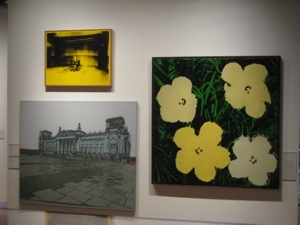
Warhol!
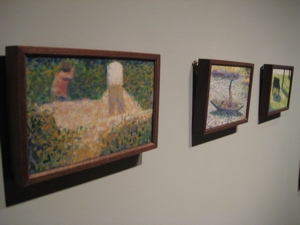
Seurat!
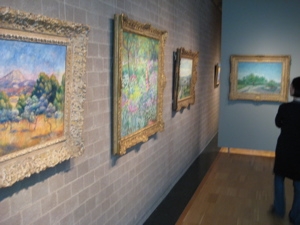
Van Gogh!
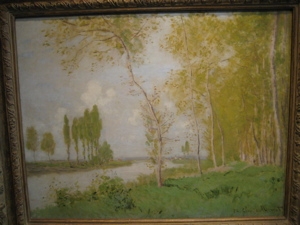
Monet!
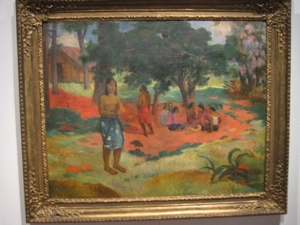
Gauguin!
To think we missed all that (in the above paragraph) and we still totally enjoyed this place! One more floor to go – the Special Exhibition 4th floor which contained at the time of our visit, “First Doubt; Optical Confusion in Modern Photography.” And yes, it was as cool as it sounds.
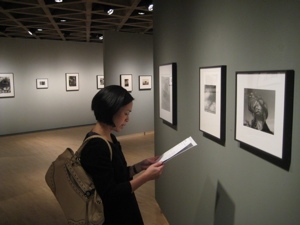 However, no photographs were allowed! And the guards were actually vigilant about it here too, which is fairly rare. Of course I snapped off a couple pictures, but none of the actual pictures. Nerd talk: “Celebrating a major gift of over two hundred photographs from the collection of Allan Chasanoff, B.A. 1961, this exhibition will explore the seldom-discussed phenomenon of optical confusion in photography. Drawn from the Chasanoff Collection, as well as from the Gallery’s permanent collection, First Doubt will feature approximately one hundred photographs by a diverse array of photographers across the twentieth century. Seen together, they reveal the interpretive nature of the lens and the interpolative nature of the photograph.”
However, no photographs were allowed! And the guards were actually vigilant about it here too, which is fairly rare. Of course I snapped off a couple pictures, but none of the actual pictures. Nerd talk: “Celebrating a major gift of over two hundred photographs from the collection of Allan Chasanoff, B.A. 1961, this exhibition will explore the seldom-discussed phenomenon of optical confusion in photography. Drawn from the Chasanoff Collection, as well as from the Gallery’s permanent collection, First Doubt will feature approximately one hundred photographs by a diverse array of photographers across the twentieth century. Seen together, they reveal the interpretive nature of the lens and the interpolative nature of the photograph.”
Steve talk: Some of these pictures were really, really cool. An example:
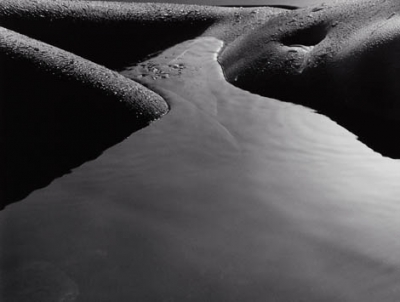
“Belly Landscape” by Karin Rosenthal.
Now that you’ve seen that, you have a better understanding what the “interpolative nature of the photograph” is all about. I picked up a paper there which contains an interview with the folks who installed the exhibit. Man, I had no idea it was so difficult to choose where to hang each picture! These people obsessed over each one’s placement, apparently.
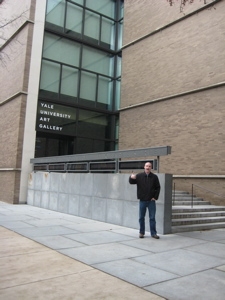 Helen stated, “I found a series of two walls where I felt there wasn’t enough energy. I used one of the works on those walls as a basis for a conceptual series of ideas and then pulled other works to create, I think, a more charged dynamic environment around that idea.” Dude, you hung some cool pictures on the wall.
Helen stated, “I found a series of two walls where I felt there wasn’t enough energy. I used one of the works on those walls as a basis for a conceptual series of ideas and then pulled other works to create, I think, a more charged dynamic environment around that idea.” Dude, you hung some cool pictures on the wall.
That was pretty much it for us… The Yale University Art Gallery is SO much more than the name suggests. I can’t believe we only say about 2/3 of it and didn’t even know it at the time! Take it from me – someone who is nowhere near an art aficionado – Definitely add this place to your Connecticut vacation itinerary.
There’s so much more to the Gallery that I didn’t even touch on… talks, presentations, studies, other exhibits, the sculpture gardens, on and on. Yeah, I think we’ll be revisiting at some point.
…………………………………………………….
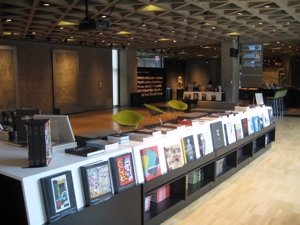
For the Curious:

 dick hemenway says
dick hemenway says
May 14, 2009 at 6:08 amSteve
The Horse and Lion painting is by George Stubbs, “Horse Attacked by Lion,” dated 1770. George Stubbs was a British painter who was known for his pictures of animals, especially horses. http://www.georgestubbs.com/
 Holly Fielder says
Holly Fielder says
September 5, 2009 at 2:52 pmI have what looks or seems to be a ceramic box signed George Stubbls Amsterdam Holland..Ingraving on the peice say B.Clark. On the top of the lid there is a painting of a women and a man on a carrage being pulled by to horses, in the backround is some landscaping of trees. I am trying to figure out if i have an antique here. Im not sure who i am writing to or if a response is expected but hope this gets me some kind of answer.
 Steve says
Steve says
September 24, 2009 at 1:51 pmHolly,
Had you read even the first paragraph or two, you’d know that you will have no luck getting help here. Sorry.
 Kenneth Casper says
Kenneth Casper says
February 3, 2014 at 12:22 amThank you for having your portrait taken with a Rothko. I’m trying to visit every Rothko on public display – a tall task – but probably not as tall a task as you have taken on in trying to visit every CT museum.
To answer the very old question from Holly – if there is a gold mark with a coat of arms with an I and a B in it held by a unicorn – you probably have the real thing. If you do it is probably worth less than $50. The picture you are referring to was done multiple times on plates mostly.